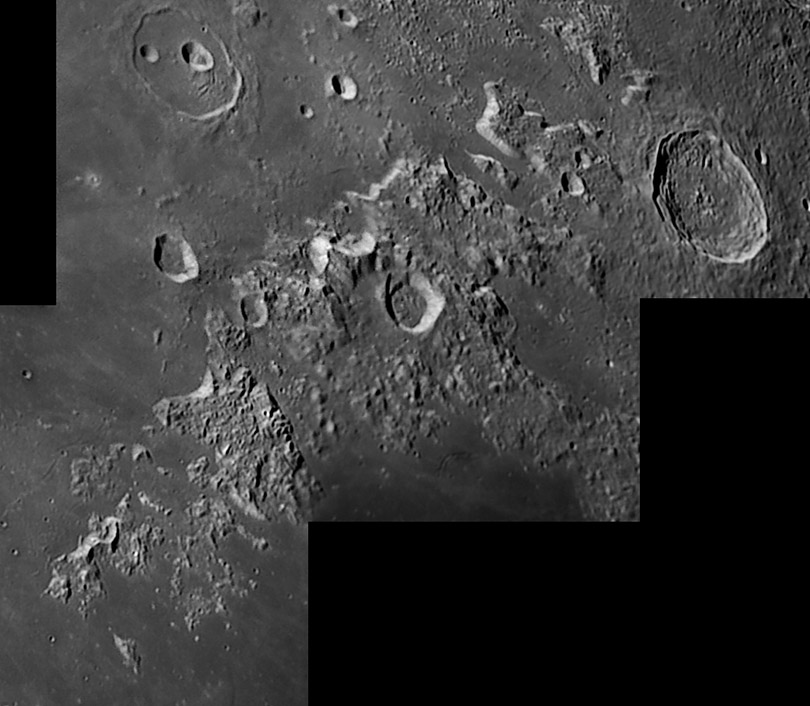Difference between revisions of "March 20, 2018"
| Line 7: | Line 7: | ||
<em>image by [mailto:g.tarsoudis@freemail.gr George Tarsoudis], Greece</em><br /> | <em>image by [mailto:g.tarsoudis@freemail.gr George Tarsoudis], Greece</em><br /> | ||
<br /> | <br /> | ||
| − | Most of the Moon's [https://the-moon.us/wiki/ | + | Most of the Moon's [https://the-moon.us/wiki/Lunar_Mons 18 mountain ranges] (<em>montes</em> in IAU's Latin) are related to impact basins, typically being part of a basin rim or ring. The Caucaus Mountains, captured here on a slant, are undoubtedly related to a basin, presumably Imbrium to the west, but the oblique angle of the Caucasus makes makes the relation unclear. The fact that the Caucasus are highest on their western edge, with a bright scarp front like the Apennines, suggest that they are part of Imbrium's rim. But if you draw a [http://www.lpod.org/coppermine/displayimage.php?pid=2326&fullsize=1 circle] around Imbrium to mark its rim, the Caucasus deviate from the circle; have they somehow been rotated counterclockwise a few degrees? Actually the southern end of the Caucasus - as far north as the area of Theaetetus - lies near the rim circle, but the Caucasus bend toward the east there and are progressively further east of the circle to the north. I have noticed before that Cassini is a break in the Imbrium-circling mountains and have [[March_19,_2006|speculated]] that the area behind (east of it) has been filled in with lava after the Caucasus rotated eastward. Sounds like a good story. <br /> |
<br /> | <br /> | ||
<em>[mailto:tychocrater@yahoo.com Chuck Wood]</em><br /> | <em>[mailto:tychocrater@yahoo.com Chuck Wood]</em><br /> | ||
Latest revision as of 18:51, 13 October 2018
Rotated Mountains?
Originally published October 30, 2008

image by George Tarsoudis, Greece
Most of the Moon's 18 mountain ranges (montes in IAU's Latin) are related to impact basins, typically being part of a basin rim or ring. The Caucaus Mountains, captured here on a slant, are undoubtedly related to a basin, presumably Imbrium to the west, but the oblique angle of the Caucasus makes makes the relation unclear. The fact that the Caucasus are highest on their western edge, with a bright scarp front like the Apennines, suggest that they are part of Imbrium's rim. But if you draw a circle around Imbrium to mark its rim, the Caucasus deviate from the circle; have they somehow been rotated counterclockwise a few degrees? Actually the southern end of the Caucasus - as far north as the area of Theaetetus - lies near the rim circle, but the Caucasus bend toward the east there and are progressively further east of the circle to the north. I have noticed before that Cassini is a break in the Imbrium-circling mountains and have speculated that the area behind (east of it) has been filled in with lava after the Caucasus rotated eastward. Sounds like a good story.
Chuck Wood
Technical Details
22 July 2008. Newtonian 10 inch st f/6.3 + DMK21AF04 + barlow 3X + Red filter with IR-cut; mosaic 7 images, Image processing Registax 4.0 and PS CS3.
Related Links
Rükl plate 13
Yesterday's LPOD: A Single Twin
Tomorrow's LPOD: Sub-Polar Marker
COMMENTS?
Register, Log in, and join in the comments.



